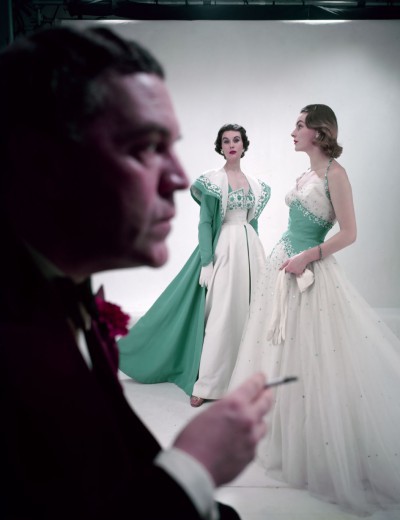
Norman Hartnell
About
Norman Hartnell was born in London, England, in 1901. He was studying at Cambridge University and was designing the costumes for the dramatic performances. They got a good review and a journalist convinced him that his future lay in designing clothes. He left Cambridge without a degree and took a job with a London dressmaker called Madame Desiree.
He was only there 3 months, but the experience convinced him that he had joined the right field. He briefly worked for Lucile and a house called Esther, and in 1923 started a salon under his own name.
His early collections, comprised tailored day ensembles and elegant evening clothes. His ceremonial clothing propelled him to fame. His first wedding dress was described in the press as "the 8th wonder of the world" and wore by the bride of Lord Weymouth.
The turning point in his career came when he designed the brides and bridesmaids dresses for the wedding of the Duke of Gloucester, 3rd son of King George V. Two of the bridesmaids were Princess Elizabeth (later Queen) and Princess Margaret.
In 1938 he was appointed dressmaker to the British Royal Family and designed gowns for overseas visits, especially for Queen Elizabeth (now the Queen Mother). The present Queen Elizabeth had her wedding gown and coronation gown (in 1953) made by Hartnell, as well as numerous of her other clothes, both casual and formal.
The dress designed for the Queen's wedding contained 10,000 seed pearls and many thousands of white crystal beads. For its display in 2003 for the anniversary of the coronation of Her Majesty The Queen, 10 restorers worked on it. In the embroidery, various symbols for different countries of the Commonwealth can be seen, such as the Scottish thistle, Australian wattle, the maple leaf of Canada and the pearly lotus flower for India.
In addition to his royal work, he designed for the theatre - for Noel Coward productions, Mistinguett and Marlene Dietrich. He was also a prolific designer of film costumes. From 1930 until 1963, Hartnell designed costumes for 21 films, including "Suddenly Last Summer" in 1960.
During the war, he was responsible for the uniforms of the British Red Cross, the Women's Royal Army Corp and the Women's Police Force. During World War II he adhered to the regulations for economic use of fabric, lack of buttons, embroidery, etc., even for the Queen and hand painted some of her dresses himself.
He was knighted Sir Norman Hartnell in 1977 (the first couturier to be so honoured).
Sir Norman Hartnell died in June 1979 at the age of 78.
Marc Bohan designed for the house of Hartnell from 1989 to 1992 and the designer Yuki also briefly worked under him in the late 60's. Gina Fratini was the designer in the 90's and several leading other well-known designers have worked at the house of Hartnell, which still creates wedding dresses and evening gowns.
The Look
Hartnell gained a reputation for imaginative use of satin, tulle, embroidery and trimmings on evening gowns, ball gowns and wedding dresses. He was also known for his tailored suits, coats and woolen tweed garments. He drew inspiration from paintings such as the Italian Masters, Renoir, Tissot, Watteau and Fragonard. King George VI took him on a tour of Buckingham Palace to show him the Winterhalter portraits of Victorian ladies, giving him the inspiration for the crinoline dresses that would become the royal look for two Queens.